POSSIBLE
MIGRATION ROOT OF VYAS FAMILY OF GAUTAM LINEAGE
9.
Possible Migration Root of Vyas Family of Gautam / Gaudumu Lineage
:
Within
one year of Muhammad's death in 632, however, Arabia was secure
enough for the Prophet's successor, Abu Bakr (632-634), the first
caliph and the father-in-law of Muhammad, to begin the campaign
against the Byzantine Empire and the Sassanid Empire.
Islamic
forays into Iraq began during the reign of Abu Bakr. In 634 an army
of 18,000 Arab tribesmen, under the leadership of the brilliant
general Khalid ibn al Walid (aptly nicknamed "The Sword of
Islam"), reached the perimeter of the Euphrates delta. Although
the occupying Iranian force was vastly superior in techniques and
numbers, its soldiers were exhausted from their unremitting campaigns
against the Byzantines. The Sassanid troops fought ineffectually,
lacking sufficient reinforcement to do more. The first battle of
the Arab campaign became known as the Battle of the Chains because
Iranian soldiers were reputedly chained together so that they could
not flee. Khalid offered the inhabitants of Iraq an ultimatum: "Accept
the faith and you are safe; otherwise pay tribute. If you refuse
to do either, you have only yourself to blame. A people is already
upon you, loving death as you love life."
Most
of the Iraqi tribes were Christian at the time of the Islamic conquest.
They decided to pay the jizya, the tax required of non-Muslims living
in Muslim-ruled areas, and were not further disturbed. The Iranians
rallied briefly under their hero Rustam and attacked the Arabs at
Al Hirah, west of the Euphrates. There, they were soundly defeated
by the invading Arabs. The next year, in 635, the Arabs defeated
the Iranians at the Battle of Buwayb. Finally, in May 636 at Al
Qadisiyah, a village south of Baghdad on the Euphrates, Rustam was
killed. The Iranians, who outnumbered the Arabs six to one, were
decisively beaten. From Al Qadisiyah the Arabs pushed on to the
Sassanid capital at Ctesiphon (Madain).
It
is highly possible that after the death of Rustam in 635 AD or after
the Karbala war in 680 AD the descendants
of Gautam / Gaudamu / Puannum left Iraq.
Along
with the descendants of Gautam / Gaudamu / Puannum and other brahmins
many other warriors like descendants of Mudgal, etc. also migrated
to India but their travel root was different.
Ancient
Egypt - Mesopotamia - India (Aryavrat) trade route :
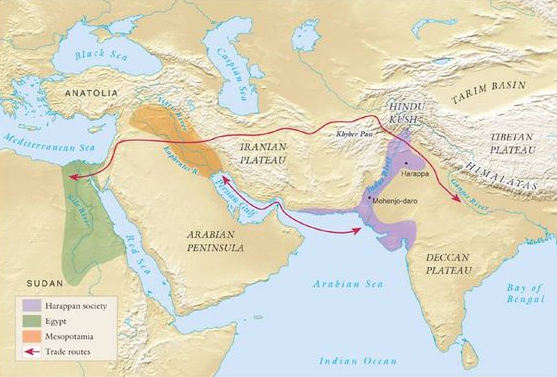
Although
we don't have specific dates for when these civilizations rose,
the three developed more or less at the same time. Equally important,
all three had contact with each other, particularly through trade.
Commerce between Egypt, Mesopotamia and India basically depended
on either an overland route or a water route. I want you to pay
close attention to the over land route, because this overland route
remained the same for centuries, later becoming the Silk Road.
Our
ancestors already knew about this trade route and hence it is possible
that they chose this route.
From
Khyber Pass to Siddhpur :
This
is just an assumption of our Vyas Family route from Khyber Pass
to Siddhpur.
| 1. |
In ancient
times Iraq and Iran was one country. The descendants of
Bharadwaj and Gautam / Gaudamu / Puannum were already living
in Iraq, Iran, etc. places before the incident of Karbala
and due to Arab invasion they had to migrate towards India.
At
the time of Karbala war (10 October 680 CE) it is said that
around 1400 Brahmin families were already living in Baghdad.
To
know more about Arab Invasion Click
here. |
| 2. |
During
Arab Invasion our Ancestors who went from Iraq or Iran to
Naimisharanya, Uttar Pradesh took route of Khyber
Pass. (The
Hindu kush
and Himalayan ranges are on the northern side of the Indian
subcontinent. Khyber and Bolan passes are two passes that
can be used to get through the Hindukush mountains.)
|
| 3. |
|
|
4. |
From
Naimisharanya located in Uttar Pradesh we came to Siddhpur
Gujarat in the year 993 A.D. |
| 5. |
We
came to perform pran pratishatha of Mulraj Solanki palace
called Rudra mahal. He had invited 1000 Brahmins from North
of India. |
| 6. |
We
are known as Audich Sahastra Brahman where Audich means North
in Sanskrut and Sahastra means 1000. Here, Audichya Sahastra
word is used but it does not means that excatly 1000 Brahmins
it can be more than 1000 Brahmins and a round figure of 1000
was taken into consideration. |
| 7. |
Mulraj
Solanki gave us Chatrala village as gift and hence we are
also known as Chatrala Vyas. |
| 8. |
Mulraj
Solanki was Agni Vanshi Rajput. |
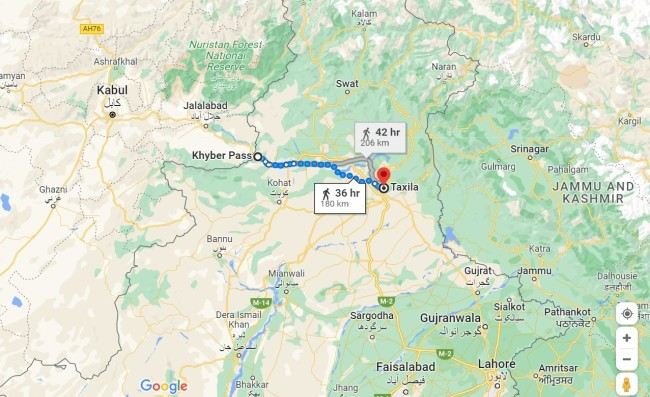
Khyber
Pass - Takshashila (Taxila)
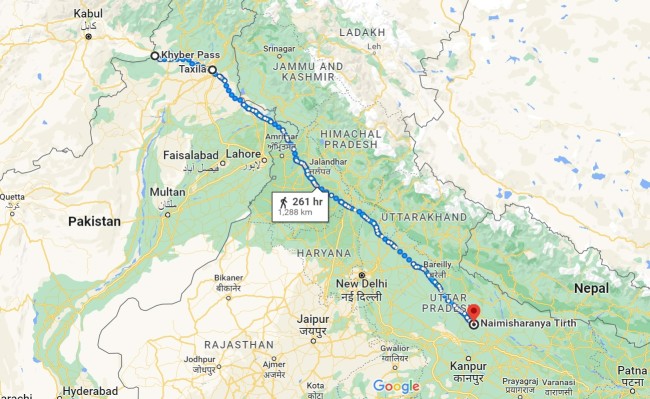
Khyber
Pass - Takshashila (Taxila) - Naimisharanya
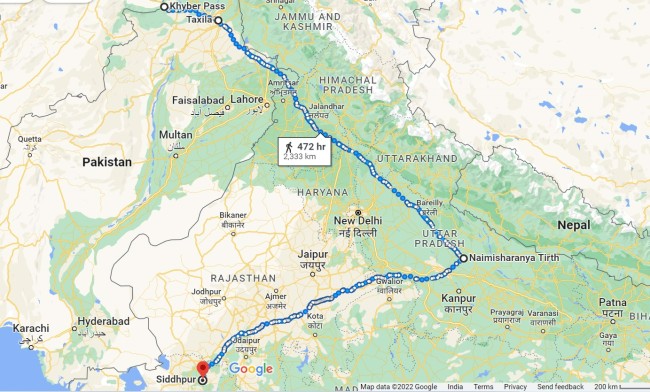
Khyber
Pass - Takshashila (Taxila) - Naimisharanya - Siddhpur
Hypothesis
:
There
are two other possible migration roots, but logically it has few
flaws which we will discuss in the end.
Route
1 :
Khyber
Pass - Zojila Pass - Beas Kund - Trishula (Trishul) - Naimisharanya
- Siddhpur.
To
know more about Route 1 Click
here.
Route
2 :
Khyber
Pass - Takshashila (Taxila) - Beas Kund - Trishula (Trishul) - Naimisharanya
- Siddhpur.
To
know more about Route 2 Click
here.
Route
3 :
Khyber
Pass - Takshashila (Taxila) - Zojila Pass - Beas Kund - Trishula
(Trishul) - Naimisharanya - Siddhpur.
Few
logical flaws in above 3 routes :
| 1. |
Gautam
(Gaudumu) was king of Kish (modern Tell al-Uhaymir), Iraq
and our ancestors lived in Iraq before migrating to India.
|
|
2. |
Iraq
has mostly flat surface with hot climate whereas Iran, Turkey,
Syria has mountainous region having cold weather along with
snowfall. |
| 3. |
People
living in hot climate having flat surface are more short tempered
and less strong as compared to people living in mountainous
region with snowfall. |
|
4. |
Since
our ancestors lived in Iraq they were not accustomed to mountainous
cold weather because of which it is possible that they took
route of Khyber Pass - Takshashila (Taxila) - Naimisharanya
- Siddhpur. |
| 5. |
The
origin of Rishi Bhrigu is of Turkey and Vashishth is Iran
which is why we see descendants of Vats, Bhrigu and Vashishth
lineage mostly living in Kashmir. |
Possible
reason for chosing route of Khyber Pass - Takshashila (Taxila) -
Naimisharanya - Siddhpur :

| 1. |
From Iran
our Ancestors took route of Kapisa
/ Kapis because according to the Chinese pilgrim Xuan
Zang who visited in 644 AD Kapis seems to have been part of
a kingdom ruled by a Buddhist Kshatriya king holding sway
over ten neighboring states including Lampak, Nagarahar, Gandhar
and Banu, according to the Chinese pilgrim Xuan Zang who visited
in 644 AD.
All
ancient sources unequivocally agree that the rulers of Kapis
were Kshatriyas from India and claimed descent from Ayodhya.
Panini, writing in 5th century BCE, Chinese travellers visiting
the kings many centuries later and even Kalhan writing five
centuries after the Chinese travellers agree on their Kshatriya
origins from India.
Hiuen
Tsang describes Kai-pi-shi as a flourishing kingdom ruled
by a Buddhist Kshatriya king holding sway over ten neighboring
states including Lampak, Nagarahar, Gandhar and Banu etc.
In
642 A.D., a "King Ta-mo-yin-t'o-ho-szu" 3 of Uddiyan
is said to have sent a gift of camphor and an embassy to the
Emperor of China. This is the year that the Arabs succeeded
in defeating the King of Kings, Yazdagird III, of Persia.
The latter, fleeing eastward, met his death near Merv in 651.
With the death of Yazdagird, last of the Sassanid dynasty,
the southern bedouin hordes of Islam for the first time marched
onto the soil of Iran and began their great, rapacious advance
eastward.
In
650 Abdallah ibn Amr began the yet further push forwards across
the desert of the Dasht-i-Lut. He was followed over the years
by succeeding Moslem armies which, through continuous raids,
massacres and looting, systematically transformed the wondrous
flower-garden of Persian civilization and Mazdean or Buddhist
culture into a scorched wasteland. Today all these lands lie
under the yoke of Arabic culture." |
| 2. |
The reason
for chosing Takshashila (Taxila) was that our ancestors knew
about it and had ancient alliance with the Takshak
Kings who also ruled Takshal or Taxila (Takshashila). |
| 3. |
From Takshashila
(Taxila) our ancestors took route of Amritsar in Punjab
to avoid cold weather of climate. |
| 4. |
Rather
than enterting India from Sindh our ancestors chose the
route of Punjab. During approx. c. 631-671 AD King Chach
established Brahmin Dynasty of Sindh by preceding Rai
Sahasi (Sinhasena) dynasty.
It is
possibly that the way in which Chach became King as mentioned
in Chachnama translated by Mirza
Kalichbeg and Manan
Ahmed our ancestors did not support Chach and / or our
ancestors had ancient alliance with rulers of Iran and Taank
Kingdom because of which our ancestors chose the route of
Punjab.
Between
6th and 7th century Punjab was ruled by Taank
Kingdom.
Taank
are Jat, Rajput and also Brahmins who previously belonged
to Takshashila.
Taank
Kingdom (also known as Takka, Tanka, or Taki) was a kingdom
based in Punjab, in 6th and 7th centuries, obtained from
the chronicles of Xuanzang and other sources. The country
was located south of Kashmir and east of Zunbil dynasty,
extending from the Indus river in the west to the Beas river
in the east, centered around modern day Sialkot.
During
Xuanzang's visit, the neighboring state of Bofadou was a vassal
(or province) of Taank. He also noted Mihirakul's capital
to have been at Sagal (modern-day Sialkot, Pakistan) within
Taank. Despite an illustrious Buddhist heritage as evident
from three colossal stups, Buddhism was in decline and was
sparsely practiced except in about ten monasteries; Brahminism
was the primary religion and there were hundreds of dev shrines.
He visited Lahore in 630 AD during Taank rule and described
it as a great Brahmin city. |
| 5. |
Rostam
Farrokhzad served as the spahbed ("military marshal")
of Sasanian
Empire (Persia / Iran) of Sasanian
Dynasty.
He was
Martired on 19 November 636 in Battle
of al-Qadisiyyah which was Sasanian Mesopotamia.
The
abrupt fall of Sassanid Empire was completed in a period
of five years, and most of its territory was absorbed into
the Islamic caliphate; however many Iranian cities resisted
and fought against the invaders several times.
It is
possible that after the death of Rostam Farrokhzad or between
636 A.D. and 641 A.D. our ancestors left Iraq through route
of Iran - Kapis by Khyber Pass - Taank by Takshashila (Taxila)
and reached Naimisharanya.
According
to a chronicle written in the 16th century, the Kissah-i-Sanjan,
the Parsis first came to India in the 8th and 10th century.
They landed in Diu, and were later given refuge in Sanjan
(Gujarat) by the local king, Jadi Rana. Five years after this
they built the first fire temple, Atash Behram, to shelter
the holy fire rescued from Iran. |
| 6. |
When the
Parsis realized that things have gone out of their hands they
migrated to India from Fars province of Iran through Persian
Gulf between 8th and 10th century.
Our
ancestors immediately took the route of Iran and migrated
to India between 636 A.D. and 641 A.D.
The
reason for choosing Iran was that it was our immediate neighbour
and we had an ancient alliance with the Iranians.
Another
reason for choosing Iran was that Rostam Farrokhzad got martyred
in Al-Qadisiyyah, Iraq and there was possibility that the
Arabs would also advance towards Basrah and block Persian
Gulf. |
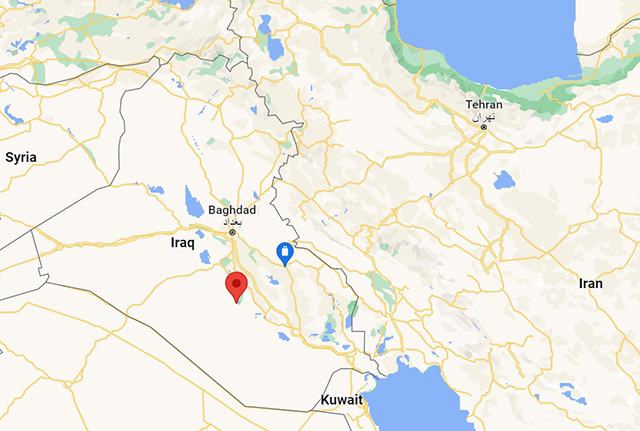
Al-Qadisiyyah
marked in red
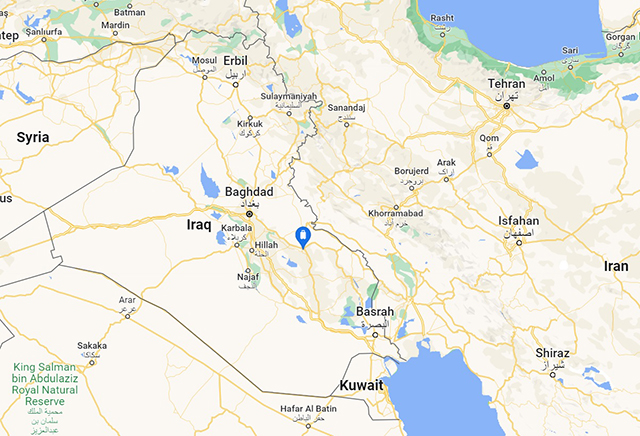
Iraq
- Iran border
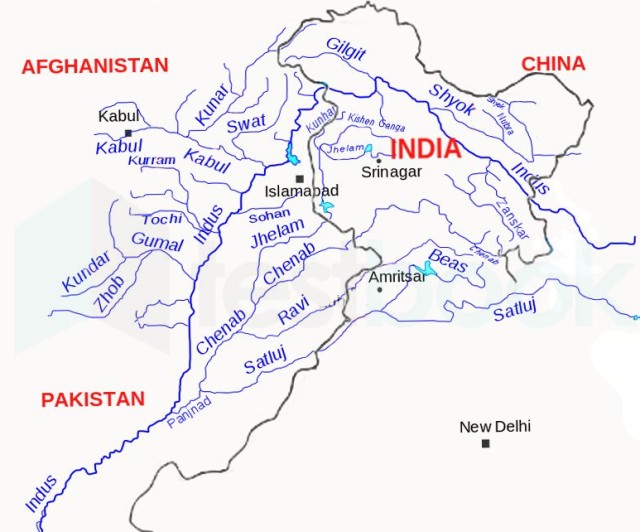
Beas
River in Punjab
Conclusion
:
Brahmins
:
The
reason why Aryan Brahmins of Iraq and Iran took route of Khyber
Pass is because it is a important Pass from which a person can enter
Taxila and Kashmir. During ancient times Taxila and Kashmir was
considered as seat of knowledge and education center of Brahmins.
Due to this reason Brahmins were familiar of this route.
Rajputs
Warriors :
The
Aryan Rajputs took the route of Bolan and Golan Pass and entered
Rajasthan because many Rajputs are of Iranian and were very familiar
with Iranian Baloch and Pashtuns warrior tribes and possibly they
had matrimonial relations with these tribes. Apart from this the
Rajputs also ruled this region for a long period of time hence they
were familiar with Bolan and Golan Pass.
Kshatriya
Warriors :
The
Aryan Kshatriya Warriors link the the family of Mudgal who later
became traders and businessman also known as Khatri / Catti / Hittites
took the route of Balochistan (Pakistan). Their possible route was
from Iraq to Shaktipeeth Shri Hinglaj Mata Mandir | Nani Mandir,
Hingol National Park, Road Asha Pura, Las Bela, Balochistan, Pakistan
to Gujarat, because being traders and businessman they were familiar
of this route.
Not
only this Brahmins, Rajputs and Kshatriyas also took charge of important
Passes and tried to stop Arab armies because of which it took Arab
armies a lot of time to enter present day India.
Unfortunately
due to destruction of Takshashila (Taxila) and Nalanda university
many innumerous important books preserved by Aryan Brahmins were
destroyed because of which at present we do not have complete information.








